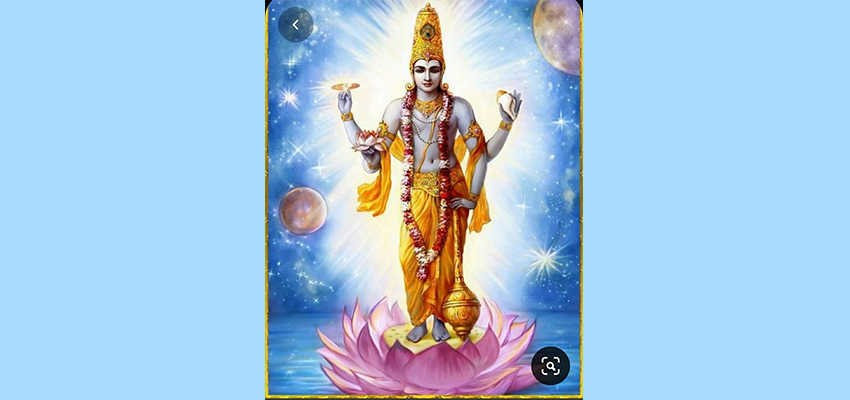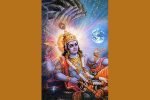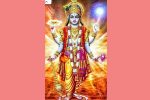NAME 10
Pūtātma पूतात्म
He is the embodiment of purity. This nāma refers to His nirguṇa aspect. Purity is the stage where guṇas, impressions and illusions are absent. The Brahman alone can be the embodiment of purity. All humans will have some traces of impurities. When one is able to transcend all the impurities, he becomes one with the Brahman.
(Though this kind of explanations may sound like a dvait (dualistic) approach, in order to explain the pre-eminence of the Brahman, such explanations become essential. Someone asked the great sage Ramana, “What is the truth of scriptural texts which speak of oneself seeing the Self and seeing God?” Ramana replied, “Since oneself is one, how can oneself see oneself? If one’s Self cannot be seen, how can God be seen? Getting absorbed is seeing.”)
Śvetāśvatara Upaniṣad (VI.xi) says, ‘kevalonirguṇaśca’ which can be literally translated as ‘He alone is without guṇas.’ Brahman cannot be explained as He is beyond any explanations.
Though He is present in all beings as soul, He is not affected by the actions of the embodiment of the soul and He continues to remain as pure as ever. He is beyond time and space (nāma 4).
Kṛṣṇa says in Bhagavad Gita (IX.9), “Actions do not bind Me, unattached I am to such actions, and standing apart as it were.”
१०. ।।ॐ पूतात्मने नमः।।
10. Om Pūtātmane Namah
Poota-atmaa -One with an extremely Pure (Pootam) Essence; One who is not affected the least by the impurities of Maya. The Self is beyond all vasanas and, therefore, He cannot be affected by any of the manifestations of Maya such as thoughts of the intellect, emotions of the mind or the perceptions of the body. Immaculate is ever the Self, and so He is termed as the Pure Self (Poota-Aatmaa). The Pure Self – One who is untainted by the effects of karma – good or bad. Puta Atmayasyasa putatma – One who has the pure Atma is pUtAtmA.
INTERPRETATION GUIDED BY SANT VANI (WORDS OF SAINTS)
Pūtātmā – The pure self
The moment one hears pure self, the mind immediately jumps to thinking about it as the opposite of the impure self. In our tradition, the major impurity/mala is ragā and dveṣa and hence the emphasis on neutralization of ragā-dveṣas or what is referred to as antah-karana-shuddhi for the person who wishes to know.
The word Pūtātmā is to be understood as one, who has self-knowledge, is not touched by the complexes of the mind or by the actions of the body. The sarvajnatva of Iśvara, includes self-knowledge also, because, all knowledge cannot be there without including self-knowledge. Iśvara knows that in spite of creating, protecting and withdrawing this world, He is akartā. He performs no actions.
If Iśvara is manifest in the form of the world, then every mind is also His manifestation. The more we dwell on this, the greater acceptance is there of our self. At the same time, it would be logical to say that all the confusions that exist in the various minds, will also belong to Him. Therefore, with the confusions of all the minds put together, Iśvara should be the most confused! Further, if He creates, protects and destroys taking recourse to the guṇas of māyā, would He not be tainted by those guṇas and actions?
Let us imagine two pots, a big pot and a small pot – suppose these pots are given a human mind. Human mind means they are conscious of themselves and able to make a judgment. Then, one would look at the other and think ‘I am a small pot. Why am I small? I do not like myself.’ From this, all kinds of problems would arise. But, if the pot were to be enlightened that its form is dependent on his own nature, clay that is independent of all form, then there would be no problem. The pot is clay but the clay is not pot. Even if there are a million pots, there is only one clay. The clay is not touched by the varieties of pots.
Just as the clay is untouched by the pot, the Lord is śhuddha, untouched by anything. He is pūtātmā, one whose ātmā, nature, is always pu̅ ta, pure, unaffected and unattached.
Literally, he whose Ātmā is pure – untouched and pristine, unperturbed by the play of the Gunas. When associated with the body the Puruṣa only assumes an apparent relationship but his real nature remains pure and unaffected by the association. So, he is ever pure.
Therefore it stands to reason that when the realization of the Ātmā and its true nature dawns on the individual JivaĀtmā, like a veil that is removed, then the JivaĀtmā becomes one with the ParamĀtmā and in this merging of the ‘Lone’ with the “Alone” all separation between the JivaĀtmā and the ParamĀtmā disappear – this is the Ādvaitic standpoint in, short.
Even here, there are large overlaps but subtle differences between the Ādvaita (अद्वैत) and Viśiṣṭādvaita (विशिष्टाद्वैत) approaches to describing this name of the Supreme being:
Śaṅkara:
One whose essence is absolute-purity He, whose Ātmā is pure The non-dual Ātmā dwelling in the heart-cave who remains untouched and his essential nature is ever-pure “Kevalo nirgunaś cá” – The non-dual, attribute-less, formless being, untouched by the Gunas
Parāsara Battar:
He who is the pure “self” Although the Bhagawan is the Ātmā in all beings and the contact with the body remains the same for the JivaĀtmā and ParamĀtmā the JivaĀtmā alone reaps the fruits of his action and is subject to suffering. The ParamĀtmā who makes the JivaĀtmā ‘experience’ joy or suffering, not only does not enjoy it but also shines brilliantly (independent and always different/separate from the JivaĀtmā Unlike the previous name where one could relate more to Parāsara Battar’s explanation, here one can see at a very practical level how Śaṅkara’s standpoint seems so much more relatable.
Here is an example to describe the Ādvaitic standpoint of the relation between the JivaĀtmā and ParamĀtmā.
Imagine that there is a glass half-full with pure water and a water droplet is positioned on the inner wall of the glass but slowly inching its way down the wall of the glass towards the water… The water droplet is separate so long as it is moving along the inner wall but the moment it touches the larger body of water (the half-full glass), the droplet and the water become one – the water droplet is the JivaĀtmā and the water is the ParamĀtmā.
He whose Ātmā is pure – untouched and pristine, unperturbed by the play of the Gunas. When associated with the body the Puruṣa only assumes an apparent relationship but his real nature remains pure and unaffected by the association. So, he is ever pure.



